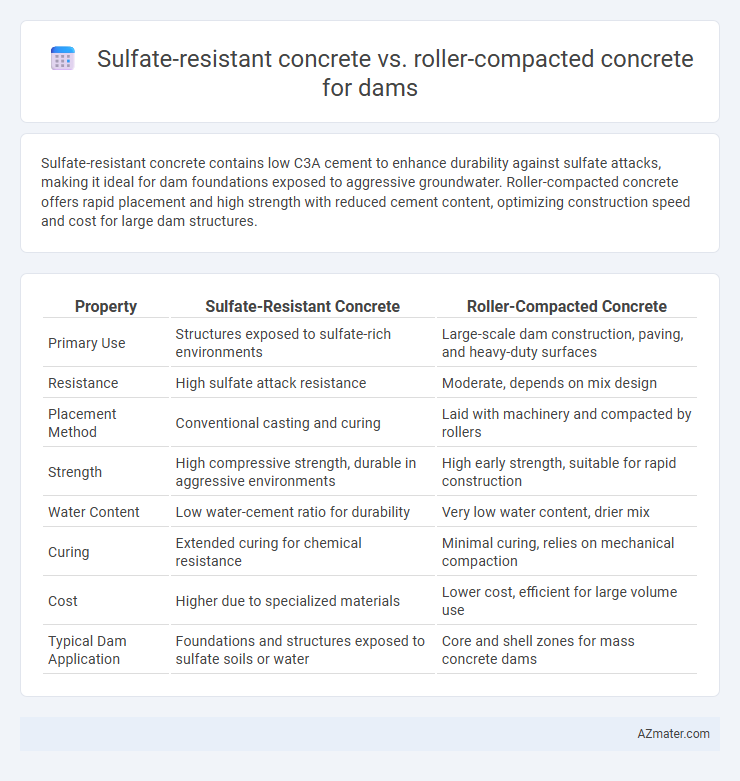Sulfate-resistant concrete contains low C3A cement to enhance durability against sulfate attacks, making it ideal for dam foundations exposed to aggressive groundwater. Roller-compacted concrete offers rapid placement and high strength with reduced cement content, optimizing construction speed and cost for large dam structures.
Table of Comparison
| Property | Sulfate-Resistant Concrete | Roller-Compacted Concrete |
|---|---|---|
| Primary Use | Structures exposed to sulfate-rich environments | Large-scale dam construction, paving, and heavy-duty surfaces |
| Resistance | High sulfate attack resistance | Moderate, depends on mix design |
| Placement Method | Conventional casting and curing | Laid with machinery and compacted by rollers |
| Strength | High compressive strength, durable in aggressive environments | High early strength, suitable for rapid construction |
| Water Content | Low water-cement ratio for durability | Very low water content, drier mix |
| Curing | Extended curing for chemical resistance | Minimal curing, relies on mechanical compaction |
| Cost | Higher due to specialized materials | Lower cost, efficient for large volume use |
| Typical Dam Application | Foundations and structures exposed to sulfate soils or water | Core and shell zones for mass concrete dams |
Introduction to Dam Construction Materials
Sulfate-resistant concrete offers enhanced durability in sulfate-rich environments, making it ideal for dam foundations exposed to aggressive groundwater. Roller-compacted concrete (RCC) provides rapid placement and high strength, suitable for large-scale dam structures requiring efficient construction. Selecting between these materials depends on site-specific environmental conditions and structural requirements to optimize dam longevity and performance.
Overview of Sulfate-Resistant Concrete
Sulfate-resistant concrete (SRC) is specifically formulated to withstand high sulfate concentrations commonly found in dam environments, using low C3A cement and supplementary cementitious materials like fly ash or slag to enhance durability. SRC minimizes sulfate attack risks by reducing permeability and preventing expansion and cracking caused by sulfate ions reacting with hydration products. Its optimized chemical composition ensures long-term structural integrity for dam construction compared to standard concrete options.
Understanding Roller-Compacted Concrete
Roller-compacted concrete (RCC) is a dry mix concrete placed with paving and compacted by rollers, offering high strength and rapid construction ideal for dam applications. Unlike sulfate-resistant concrete, designed to withstand chemical attacks in aggressive environments, RCC emphasizes cost-effectiveness, durability, and speed of placement without requiring formwork. Understanding RCC's unique mix design and mechanical compaction process is crucial for optimizing dam structural integrity and project timelines.
Key Material Properties Comparison
Sulfate-resistant concrete exhibits enhanced durability by using low-tricalcium aluminate cement, which significantly reduces sulfate attack and ensures structural integrity in aggressive environments. Roller-compacted concrete combines high compressive strength and rapid placement with a lower water-cement ratio, providing excellent density and abrasion resistance essential for dam construction. Both materials optimize durability and performance, but sulfate-resistant concrete prioritizes chemical resistance while roller-compacted concrete emphasizes mechanical strength and constructability.
Performance in Aggressive Chemical Environments
Sulfate-resistant concrete (SRC) exhibits superior durability and longevity in aggressive chemical environments by minimizing damage from sulfate attack, making it ideal for dam structures exposed to sulfate-rich soils or waters. Roller-compacted concrete (RCC) offers high compressive strength and rapid construction but may require careful mix design adjustments to enhance its chemical resistance against sulfates and other aggressive ions. SRC's specialized cement composition significantly reduces permeability and chemical degradation, while RCC's performance depends largely on its mix formulation and compaction quality to withstand prolonged exposure to aggressive environmental conditions.
Structural Strength and Durability
Sulfate-resistant concrete offers enhanced durability in dam construction by resisting chemical attacks from sulfate-rich environments, thereby maintaining structural integrity over time. Roller-compacted concrete provides superior structural strength due to its dense, compacted composition and rapid placement, which reduces shrinkage and cracking. Both materials contribute to long-lasting dam infrastructure, with sulfate-resistant concrete excelling in chemical durability and roller-compacted concrete optimizing mechanical strength and construction efficiency.
Construction Methods and Speed
Sulfate-resistant concrete employs conventional casting methods with longer curing times to withstand aggressive sulfate environments, ensuring durability but resulting in slower construction progress. Roller-compacted concrete (RCC) uses a dry mix compacted with heavy rollers, enabling rapid placement and faster construction schedules ideal for large dam projects. RCC's accelerated construction speed contrasts with the more time-intensive curing process of sulfate-resistant concrete, making RCC preferable when project timelines are critical.
Cost Comparison and Budget Considerations
Sulfate-resistant concrete typically incurs higher material costs due to specialized cement and additives essential for durability in aggressive sulfate environments, impacting the overall budget for dam projects. Roller-compacted concrete (RCC), with its lower cement content and efficient placement methods, generally offers cost savings in labor, formwork, and time, making it a budget-friendly option for large-scale dam construction. Evaluating the total lifecycle cost, including maintenance and durability requirements, is crucial when choosing between sulfate-resistant concrete and RCC for dam projects.
Environmental Impact and Sustainability
Sulfate-resistant concrete minimizes environmental degradation in dam construction by reducing the need for repairs and extending structure lifespan, thus lowering carbon emissions associated with maintenance and reconstruction. Roller-compacted concrete offers sustainability advantages through faster placement and reduced cement content, which decreases overall greenhouse gas emissions and energy consumption during production. Both materials contribute to eco-friendly dam projects, with sulfate-resistant concrete excelling in chemical durability and roller-compacted concrete optimizing resource efficiency.
Selecting the Optimal Concrete for Dam Projects
Selecting the optimal concrete for dam projects requires evaluating sulfate-resistant concrete and roller-compacted concrete based on durability and structural performance. Sulfate-resistant concrete offers enhanced resistance against chemical attacks from sulfate-rich water, making it ideal for environments with aggressive groundwater conditions. Roller-compacted concrete provides rapid placement and high compressive strength, promoting efficient construction and long-term stability, especially in large-scale dam structures.

Infographic: Sulfate-resistant concrete vs Roller-compacted concrete for Dam
 azmater.com
azmater.com